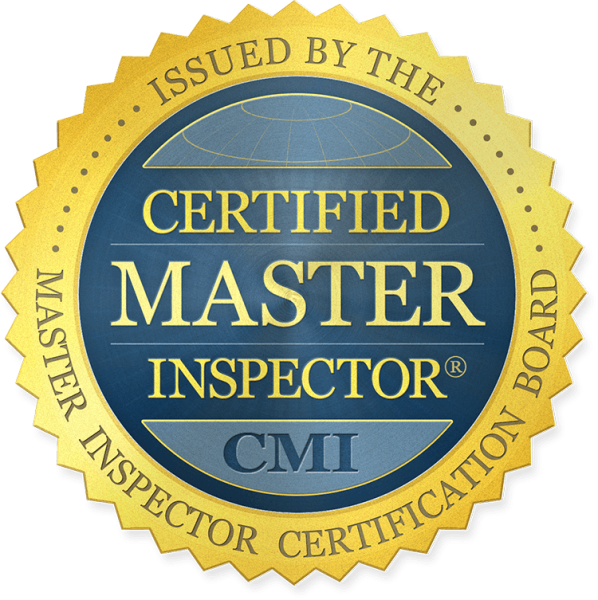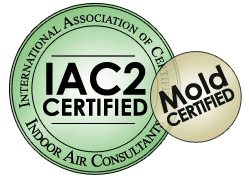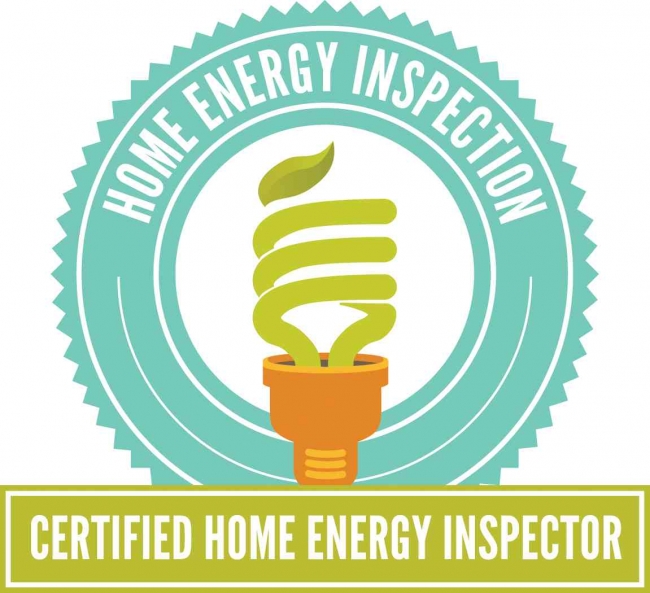Common Questions Concerning Mold
What is Mold ?
Molds are not plant, animal, or mineral. They are in their own class - fungi. Molds grow in the natural environment, and always have. In nature, molds help break down dead materials, and can be found growing on soil, foods, plants and other items. Molds are also very common in buildings and homes. Mold needs moisture to grow. Indoors, mold growth can be found where humidity levels are high, such as basements and showers, and sometimes in attics. Molds produce microscopic cells called "spores" that are spread easily through the air. Spores can also be carried by water and insects. Live spores act like seeds, forming new mold colonies when they find the right conditions.
What makes mold grow?
Mold only needs a few things to grow and multiply: Nutrients (food source), a suitable, undisturbed area to grow on, and moisture.
Many building materials (such as wood, sheetrock, and even glass, etc.) are food sources and surfaces that can support mold growth. Even dust that has settled on these materials or furniture can be a food source for molds. Molds can grow almost anywhere that moisture or high humidity exists. Controlling moisture is the solution to stopping indoor mold growth, because all molds require water. Moisture can come from:
Flooding from the outside (storm water, overflowing lakes, streams, storm surge, etc.)
Flooding from the inside (overflow from sinks, tubs, toilets, air conditioner drain pans or sewerage systems)
Condensation (caused by indoor humidity that is too high or surfaces that are too cold)
Water leaks from outside the structure (roof, walls, floors)
Indoor plumbing leaks like dripping or broken water supply and drain pipes
Outdoor sprinkler spray hitting the walls, or indoor fire sprinklers
Improper venting of kitchen and bathroom moisture (steam from shower or cooking)
Humidifiers
Hanging wet clothes indoors, or venting dryers indoors and in crawl spaces.
House plants (over watering, etc.)
Moisture from our bodies (sweat, wet hair on pillows, breath)
Warm, moist air from outdoors
Liquid spills
Should I be worried about mold in my home?
Possibly. There will always be mold in your home in the form of spores and mold cells. The presence of mold in the air is everywhere, and is normal. But you should not let mold grow and multiply indoors. When this happens, your level of exposure can increase, as well as your sensitivity, thereby increasing the risk of potential health problems. Building materials, household goods and furnishings may also be damaged. Mold needs to eat to survive, and it's content with eating your home if you allow it.
What health problems can be caused by mold?
Some health problems that come from exposure to mold are allergic illness, irritant effects, infection, and even toxic effects. People that are sensitive to molds may have symptoms such as nasal and sinus irritation or congestion, dry hacking cough, wheezing, skin rashes or burning, watery or reddened eyes may occur. People with severe allergies could have more serious reactions, such as hay-fever-like symptoms and shortness of breath. People with chronic illnesses or people with immune system problems may be likely to get infections from certain molds, viruses and bacteria. Molds can also trigger attacks in persons with asthma. Headaches, memory problems, mood swings, nosebleeds and body aches and pains are sometimes reported as mold complaints, but mold has not been proven to be the root cause. The toxic effects of molds are not well understood, and are currently a controversial topic in the medical and scientific community. There is evidence of specific long-term toxic effects from eating foods with mold toxins. Unfortunately, very little is known regarding the actual health risks from breathing in or skin contact with mold toxins. Allergic disease is now considered the most likely health problem related to mold exposures. Research into the possible health effects related to mold exposure continues today.
How can I tell if there is mold in my home, or should I test my home for mold?
Indoor mold growth can usually be seen or smelled. In most cases, if visible mold growth is present, sampling is not necessary. There are no health or exposure-based standards that can be used to evaluate a mold sampling result. The WV Department of Health does not recommend mold testing or sampling to see if you have a mold problem, or to see what kind of mold might be growing. Sampling for mold in the air can be expensive, and should only be done by experienced professionals with proper training and equipment. Investigating is more effective than testing.
Look for visible mold growth (it can look cottony, velvety, rough, or leathery and have different colors, such as gray, brown, black, yellow, white, or green). Mold often appears as a fuzzy growth or stain on furniture and building materials (walls, ceilings, or anything made of wood or paper). Look for signs of moisture or water penetration (water leaks, standing water, water stains, condensation, etc.).
Check around air handling units (air conditioners, furnaces) refrigerators, and freezers for standing water. Routinely inspect the evaporator coils, liner surfaces, drain pans and drain lines.
Search areas particularly where you notice strong mold odors. If you can smell an earthy or musty odor, you may have a mold problem.
If mold-allergic people have some of the symptoms listed above when in or immediately following a visit to your home, you may have a mold problem.
How can I be exposed to mold?
Mold is virtually everywhere, floating in the air and on surfaces. People are exposed to molds 24 -7, 365 days a year. Exposures increase if indoor moldy materials are dried, damaged or disturbed, causing spores and other mold cells to be released into the air and inhaled. Elevated exposure can also occur if people directly handle moldy materials or even accidentally eat mold.
How much mold does it take to make me sick?
This is a very difficult question, because every person and situation is unique. What one person can tolerate with no effect may cause symptoms in another individual. It’s kind of like trying to figure out how long a person can be in the sun without getting a sunburn.
The presence of indoor mold could eventually become unhealthy for anyone if they are exposed long enough. People with special health concerns should consult a medical doctor if they feel their health is affected by indoor mold. Certain people may be affected sooner and more severely than others, including: Babies and children, Elderly persons, Individuals with chronic respiratory conditions or allergies or asthma, people having weakened immune systems (for example, people with HIV or AIDS, chemotherapy patients, or organ transplant recipients)
Are some molds more hazardous than others?
Some molds can produce chemicals called "mycotoxins". These molds are quite common, and are sometimes referred to as "toxic mold". There are very few reports that "toxic molds" inside homes can cause unique or rare health conditions. If you think you have a mold problem in your home, you do not need to find out what type of mold you may have. All molds should be treated the same when it comes to health risks and removal. All indoor mold growth should be removed promptly, whether or not it can produce mycotoxins.
What is Black Mold and how dangerous is it?
Stachybotrys chartarum (also known as Stachybotrys atra) is a greenish-black mold that can grow on materials such as drywall or sheetrock, ceiling tiles, and wood when they become moist or water-damaged. Not all greenish-black molds are Stachybotrys chartarum. Some strains of Stachybotrys chartarum may produce mycotoxins. Whether a mold produces mycotoxins depends on what the mold is growing on and conditions such as temperature, pH, humidity or other factors. When mycotoxins are present, they occur in both living and dead mold spores, and may be present in materials that have become contaminated with molds. While Stachybotrys is growing, a wet slime layer covers its spores, preventing them from becoming airborne. When the mold dies and dries up, air currents or physical handling can cause spores to become airborne. Mold does not have to be black to contain mycotoxins, and mold that is black doesn’t always carry mycotoxins. The color of the mold has nothing to do with how dangerous it is or can become.
Currently, there is no test to determine whether Stachybotrys growth found in buildings is producing toxins. There is also no blood or urine test that can tell if an individual has been exposed to Stachybotrys chartarum spores or its toxins.
Can Stachybotrys affect my health?
Typically, indoor air levels of Stachybotrys are low. As with other types of mold, higher levels can cause adverse health effects. These include cold-like symptoms, rashes, sinus inflammation, eye irritation and aggravation of asthma. Some symptoms are more general - such as inability to concentrate or fatigue. Usually, symptoms disappear after the mold is removed.
How can I tell when Stachybotrys chartarum is present ?
Many molds are black but are not Stachybotrys. For example, the black mold often found between bathroom tiles is not Stachybotrys. Stachybotrys can be identified only by specially trained professionals through a microscopic exam or by cultures. The WV Department of Health does not recommend that people sample mold growth in their home. All indoor mold growth should be removed, regardless of type.
How can I prevent mold growth?
Two Words-Remove moisture. Without it, mold growth cannot start, much less multiply and spread. The easiest way to prevent the mold from gaining a foothold is to control moisture. Keep your home clean and dry. When water stands for as little as 24 hours, common molds can start growing. Keeping humidity levels below 60% and venting moisture from showering and cooking to the outside are some easy ways to prevent the conditions that can lead to mold growth. Other ways include:
Clean and dry up spills within 24 hours
Dry out wet building materials and carpets within 24 hours of becoming wet.
Use an air conditioner or a dehumidifier to maintain the indoor humidity levels below 60%. If you have a central air conditioning system and also need a dehumidifier to keep the humidity below 60%, you should have the air conditioning system examined for problems
Do not carpet bathrooms or basements
Note: While most experts suggest a relative humidity of less than 60%, below 50% is best for controlling both mold growth and dust mites. Dust mites are microscopic animals related to spiders, ticks and other mites. Dust mites eat mold and dead human or animal skin scales (flakes) and leave allergenic proteins. Dust mites reduce allergen production at these lower humidity levels.
How Should Mold Be Cleaned?
Mold should be cleaned immediately when noticed. People cleaning the mold should be free of symptoms and allergies. Small areas (10 sq ft) can be cleaned using a detergent/soapy water or a commercial mildew or mold cleaner. Gloves and goggles should be worn during cleaning. The cleaned area should then be thoroughly dried. Throw away any sponges or rags used to clean mold.
If the mold returns quickly or spreads, it may mean you have an underlying problem, such as a water leak. Any water leaks must be addressed to solve mold problems. If there is substantial mold growth, consult the U.S. Environmental Protection Agency's booklet: "Mold Remediation in Schools and Commercial Buildings". It is available free by calling the EPA Indoor Air Quality Information Clearinghouse at (800) 438-4318, or on the Internet at http://www.epa.gov/mold/mold_remediation.html. If the moldy material surface cannot be easily cleaned, such as drywall, carpet padding and insulation, then removal and replacement may be necessary.
Should I use bleach to clean mold?
Using bleach or other chemicals to kill indoor mold growth is not needed in most cases. The goal should be to remove mold growth by cleaning or removing moldy materials. Dead mold can still pose health risks if you are exposed. Using bleach or other disinfectants on surfaces after mold removal may be needed where people are thought to be susceptible to fungal infections (such as a person with immune system problems). Should you decide to use bleach or another chemical, please read and carefully follow the label directions and hazard statements.
Do not mix bleach with ammonia cleaners or acids like vinegar, because a dangerous chlorine gas may be formed.
Should I hire a professional for the cleanup?
Who should do the cleanup depends on a few factors. One is the size of the mold problem. If the moldy area is less than about 10 square feet (less than roughly a 3 ft. by 3 ft. patch), in most cases, you can handle the job yourself. However,
If there has been a lot of water damage, and/or mold growth covers more than 10 square feet, consult the U.S. Environmental Protection Agency (EPA) guideline: "Mold Remediation in Schools and Commercial Buildings. Although written about schools and commercial buildings, this document also helps when dealing with mold in any structure.
If you choose to hire a contractor (or other professional service provider) to do the cleanup, make sure the contractor has experience remediating mold. Check references and credentials, and ask the contractor to follow the recommendations in EPA's "Mold Remediation in Schools and Commercial Buildings, the guidelines of the American Conference of Governmental Industrial Hygienists (ACGIH), or other guidelines from professional or government organizations.
If you think the heating or air conditioning (HVAC) system may be contaminated with mold, read the EPA's guide "Should You Have the Air Ducts in Your Home Cleaned?" before taking further action. Visit www.epa.gov/iaq/pubs/airduct.html, or call (800) 438-4318 for a free copy.
If you have concerns regarding your health before starting the cleanup, consult your doctor.
Note: The EPA suggests the following: "Do not run the HVAC system if you know or suspect that it is contaminated with mold - it could spread mold throughout the building". Unfortunately, it is thought that most, if not all, heating and air conditioning systems will support mold growth at some point. Stopping the use of an air conditioning system due to suspected mold growth would make most WV buildings very uncomfortable during the summer months. Should you turn off an air conditioner if a mold problem in the system is found? Ideally, yes. The system should be shut down while cleaning or mold removal is performed. If the water and/or mold damage was caused by sewage or other contaminated water, then call a professional who has experience cleaning and fixing buildings damaged by contaminated water.
Who can I call if I suspect that I have a mold problem, or if I want more information on mold?
Inspection Connection is trained and Certified in Mold Inspections, and Consultations in remediations.
For additional information about the health effects of mold exposure and information on the safe removal of mold, please call your County Health Department's Environmental Health Office, the WV Department of Health, Radon and Indoor Air Program, or the U.S. Environmental Protection Agency's Indoor Air Quality Information Clearinghouse at 1-800-438-4318.
Inspection Connection
Michael A Clark, Certified Master Inspector©
IAQ2 Certified
(304) 610-4018
![]()









